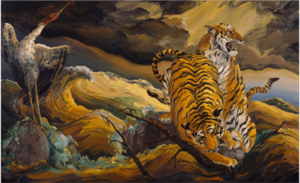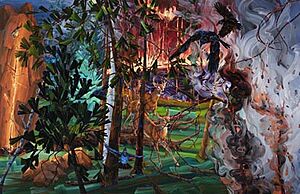Melissa Miller (artist) facts for kids
Quick facts for kids
Melissa Miller
|
|
|---|---|
| Born | 1951 Houston, Texas, United States
|
| Nationality | American |
| Education | University of New Mexico |
| Known for | Painting, drawing, sculpture |
| Awards | Anonymous Was A Woman Award, National Endowment for the Arts, Texas Commission on the Arts |
Melissa Miller (born 1951) is an American artist. She is famous for her paintings of animals. These paintings often tell stories and show how animals behave. Critics have called her work "raucous allegorical paintings." This means her art uses animals to represent ideas or feelings.
Miller became well-known in the early 1980s. This was a time when many artists started painting real-life subjects again. Her work has been shown in many important museums. These include the Whitney Museum, the New Museum, and the Museum of Modern Art. She has also received several awards for her art. Melissa Miller lives and works in Austin, Texas.
Contents
About Melissa Miller's Life
Melissa Miller was born in Houston, Texas. She spent a lot of her life in the countryside of central Texas and the mountains of northern New Mexico. These places influenced her art. She studied art at the University of New Mexico. She earned her Bachelor of Fine Arts degree in 1974.
Early Career and Recognition
Miller's art quickly gained attention. She had early shows at museums like the Dallas Museum of Fine Arts. She also showed her work at the Laguna Gloria Art Museum. In 1984, she was chosen for the Venice Biennial. This is a very important art exhibition that brought her national and international fame.
She also participated in the Whitney Biennial in 1983. Her paintings were shown at the San Francisco Museum of Modern Art in 1984. From 1984 to 1995, her art was displayed at the Holly Solomon Gallery in New York.
Teaching and Later Exhibitions
Later in her career, Miller continued to show her art widely. Her work has been featured at the Museum of Fine Arts, Houston. She also taught art at the University of Texas at Austin from 1998 to 2011. She retired as an Associate Professor Emerita. Before that, she taught at other universities too.
Exploring Melissa Miller's Art
Miller's paintings often feature animals. She finds that animals can express strong feelings and ideas. Her early works from the late 1970s showed farm animals and people. These scenes were often lively and colorful.
Animals in Her Art
By the early 1980s, Miller focused mainly on animals. She painted both common and exotic species. Her paintings showed animals in moments of fear, anger, or joy. For example, her painting Flood (1983) shows two tigers and a crane on rocks during a heavy rain. Critics found these early animal paintings to be new and exciting.
Around 1985, her animal paintings became more realistic. These animals sometimes appeared with human-like figures or mythical characters. Her art often explored inner feelings and difficult life questions. She drew inspiration from folk tales. Examples include Broken Wing (1986) and Night Sky (1995). These paintings show themes like danger and change.
Focus on Nature and Environment
In the early 2000s, Miller's art changed again. She noticed that natural places were disappearing. She also saw more imported animal species in Texas. Her paintings began to combine farm animals with exotic ones. These works often showed animals looking cautious or calm. They hinted at how strangers might relate to each other. They also explored ideas of immigration and belonging.
More recently, Miller's art has focused on environmental issues. She paints landscapes that are changing or damaged. She shows shrinking wild areas and animals that have lost their homes. For example, Forest Fire (2019) shows deer and birds escaping a huge fire. Other works, like Ghost Net (2013), show sea animals in danger from human activities. Since 2017, she has also created animal sculptures from clay and metal.
Art Collections and Awards
Melissa Miller's artwork is part of many public art collections. These include the Museum of Modern Art in New York. Her art is also at the National Museum of Women in the Arts. Other museums holding her work include the Museum of Fine Arts, Houston and the Dallas Museum of Art.
She has received many awards for her contributions to art. These include the Anonymous Was a Woman award in 2003. She was named Texas Two-Dimensional Artist of the Year in 2011. She also received three grants from the National Endowment for the Arts.
Books About Melissa Miller
- Kalil, Susie & Michael Duncan, Melissa Miller, University of Texas Press, 2007 ISBN: 029271422X
- Miller, Melissa, A Bestiary by Melissa Miller, K2 Press, Austin, Texas, 2007.
- Miller, Melissa, Melissa Miller: Paintings, 1986-1995, Holly Solomon Gallery, New York, 1995
- Miller, Melissa, Melissa Miller: A survey, 1978-1986, Contemporary Arts Museum, Houston, 1986 ISBN: 0936080175




